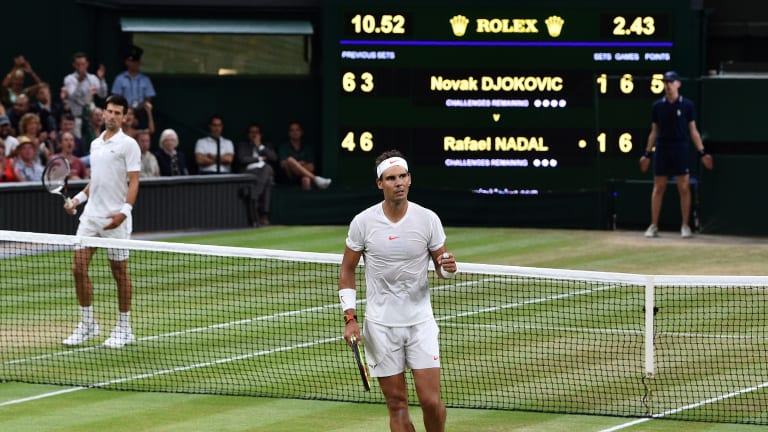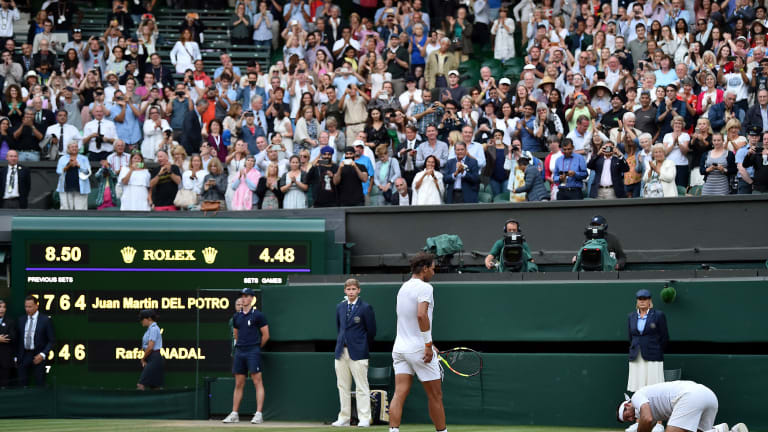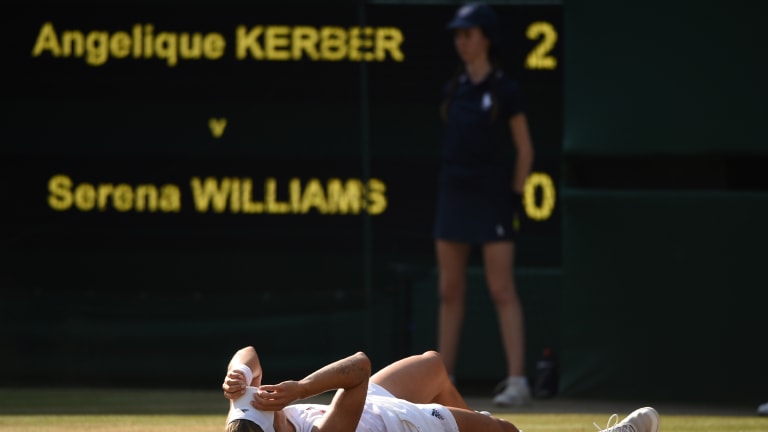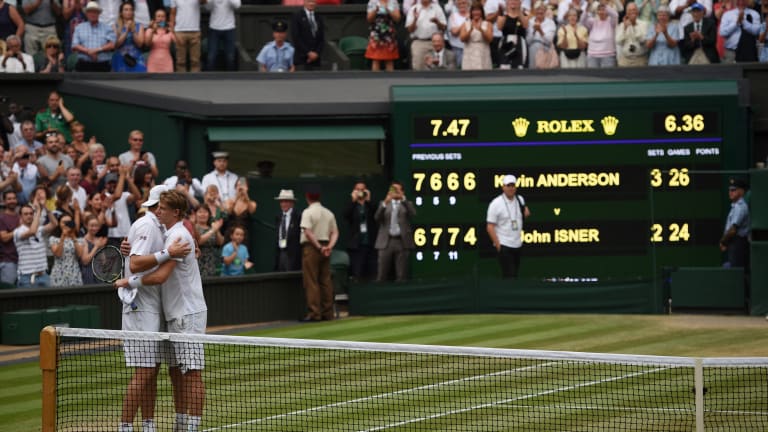Wimbledon
Debating best-of-three sets vs. best-of-five
By Steve Tignor May 21, 2021Wimbledon
The battle for No. 1 & more: Four WTA takeaways from the Wimbledon fortnight
By Joel Drucker Jul 17, 2023Wimbledon
Can anyone stop Alcaraz or Djokovic? Four ATP takeaways from the Wimbledon fortnight
By Joel Drucker Jul 17, 2023Wimbledon
Carlos Alcaraz's Wimbledon trophy keeps him at No. 1, Marketa Vondrousova's lifts her to No. 10
By Associated Press Jul 17, 2023Wimbledon
Analysis: Carlos Alcaraz's Wimbledon title shows he is exactly who everyone thought he was
By Associated Press Jul 17, 2023Wimbledon
Wimbledon champ Carlos Alcaraz shows us there’s no need to rein in expectations for him
By Steve Tignor Jul 16, 2023Wimbledon
Hsieh Su-Wei and Barbora Strycova win second women's doubles title together at Wimbledon
By Associated Press Jul 16, 2023Wimbledon
Novak Djokovic rues his missed chances after losing a highly entertaining Wimbledon final in five sets
By Associated Press Jul 16, 2023Wimbledon
Fairytale Finish: Barbora Strycova wins last Wimbledon with Hsieh Su-Wei
By David Kane Jul 16, 2023Wimbledon
Carlos Alcaraz becomes sixth player to defeat Novak Djokovic in a Grand Slam final
By Matt Fitzgerald Jul 16, 2023Wimbledon
Debating best-of-three sets vs. best-of-five
Most of the arguments against best-of-five at the Grand Slams aren't convincing. But there is one scenario where a change would make sense.
Published May 21, 2021
Advertising
"I mean, winning Grand Slam, playing best-of-three demand to the player something else, no? Stronger mentally, stronger physically, be solid for such a long time and for such a long two weeks. So I really believe that's the right thing to do."—Rafael Nadal, on Sunday
"I am more of a proponent of best-of-three sets everywhere. You asked me why. I just feel that we have enough tournaments, enough matches during the year. We have the longest season of all sports, any sport in the world. Tennis has the longest season from January 1 to end of November. Literally every single week you have tournament somewhere."—Novak Djokovic, on Monday
Advertising
"I think majors should stay best-of-five. It's tradition. It's the way it always was, and it makes it very special."—Dominic Thiem, on Tuesday
The debate over playing best-of-three-set or best-of-five-set tennis on the men's side at the Slams hasn't just not gone away—it may have only intensified since Steve Tignor's deep dive into the subject last June. Published just a few weeks before Djokovic and Roger Federer would play to a 13-12 fifth-set tiebreaker at Wimbledon, this feature expands upon many of the reasons these three ATP Finals participants and major champions used to back up their opinions.
Read on, then vote on Twitter, if you're up for another contentious election.—Ed McGrogan, on Wednesday
The Spaniard survived hard-fought four-set matches in the third and fourth rounds, then survived an even harder-fought five-setter against Dominic Thiem in the quarterfinals—a gruelingly brilliant contest that ended after 2:00 A.M. and was immediately lauded as one of the greatest matches in US Open history. But it was a triumph that came with a price: two days later, the chronic tendinitis in Nadal’s knees flared again, and he was forced to retire in the second set of his semifinal against Juan Martin del Potro.
By the time it was over, Nadal’s 16-hour on-court adventure had become one more thing: the perfect crystallization of an argument—with both sides’ views equally represented—that has been growing more heated in recent years. The dispute can be summed up with a deceptively simple question: Should the men continue to play best-of-five sets at Grand Slam tournaments, or should they play best-of-three sets instead?
Those with a traditionalist streak favor sticking with best-of-five, a format that has been in place since the very first Wimbledon, in 1877. Supporters see it as a fairer measure of a player’s skills than best-of-three, with the extra set (or two) giving the better, fitter competitor more time to prove his superiority. Because other events on the ATP are best-of-three, the extended format also ensures that the Grand Slams remain the sport’s ultimate trials by fire, and unique events. If generations of past men’s champions persevered through best-of-five, why can’t today’s?
Pat Cash, Wimbledon champion in 1987, states the case for traditionalists when he says, “The simple fact is, best-of-five sets is the ultimate test of mental and physical stamina; it’s what’s worthy of a Grand Slam event.”
Those with a reformist streak are in favor of one of two changes, each promoting gender parity: (1) having the men play best-of-three, or (2) having the women play best-of-five. For many, though, the objective is to lessen the men’s workload. Supporters say playing best-of-three would lead to fewer injuries and leave players fresher in later rounds. It would make matches easier for spectators to sit through, and easier for TV networks to broadcast. And having the men play the same amount of tennis as the women would eliminate an age-old obstacle to the idea of equal pay.
Novak Djokovic, the highest-profile player to sign on to the best-of-three movement, stated the case for change when he said, “This new generation of fans and millennials, they don’t have the great[est] attention span. They want things to happen very quickly. So for the players, as well as to attract more people—more viewers of a younger audience—I think we have to keep matches dynamic.”
At the US Open, Nadal proved both sides’ points at once. First, his win over Thiem was shown as evidence that epic, memorable matches are only possible with best-of-five.
“When things happen like this, the atmosphere and the crowd become more special,” Nadal said afterward. “People get involved.”
Two days later, detractors pointed to Nadal’s retirement as evidence that the lengthier format no longer makes sense at a time when tennis is more physically punishing than ever.
“Best-of-five is carnage,” tweeted the New York Times’ Ben Rothenberg.
Some in the sport agree. One of tennis’ most tradition-minded events, Davis Cup, downsized from best-of-five to best-of-three, and the Olympics will do the same with the men’s gold-medal match. Thus far, though, the Slams haven’t considered following suit.
“At this point, the US Open has no plans to change the best-of-five sets format for the men,” a USTA official says.
Roger Federer put it even more bluntly: “I mean, it won’t happen,” he said last summer. But he was willing to admit that “it’s a fun debate to have.”
So let’s have it.

The Long and Short of It: Debating best-of-three sets vs. best-of-five
© AFP/Getty Images
Advertising
Playing multiple lengthy matches over a two-week span comes with risks, but the more important question may be: is there an injury crisis in the first place, and would switching to best-of-three help solve it?
Injuries are unquestionably a hot-button issue on the ATP tour. Federer, Nadal, Djokovic, del Potro and Stan Wawrinka have all undergone surgery in recent years, and Andy Murray is contemplating retirement because of a chronic hip problem.
“With two of the majors on hard courts, and the amount of running the players have to do now, the wear and tear is greater than ever,” Hall of Fame player Pam Shriver says.
But while that may be true, it doesn’t seem to be hurting the players’ longevity. All of the men mentioned are in their 30s, an age at which many past champions had already retired. Federer is the oldest No. 1 in history, and Nadal is the oldest French Open champion since 1968. The sport is more physical than ever, but the players have learned to handle its effects.
Djokovic aside, few men’s players have expressed a wish to discard best-of-five, a format they play in only four tournaments each year. Of the 77 matches that young Alexander Zverev played in 2018, only nine lasted longer than three sets. If the men blame anything for injuries and exhaustion, it’s the 11-month schedule, which allows little time to recuperate.
“It’s not the amount of tennis we play inside that year,” Zverev said last November. “It’s more about how much off time we can actually have. Even if you’re not playing for a week in a tournament, you can’t take that week off; you have to be training...We don’t have time to give ourselves rest.”

The Long and Short of It: Debating best-of-three sets vs. best-of-five
© AFP/Getty Images
Advertising
After 15 years of grinding away on tour, Andy Murray had a sudden change of heart at Wimbledon last summer.
“As a player, I really like best-of-five,” Murray told the New York Times. “I feel like it rewards the training and everything you put into that.”
But that was before Murray was hired to commentate on the quarterfinal between Nadal and del Potro at that same tournament. The five-set match lasted so long—four hours and 47 minutes—that Murray missed a dinner reservation.
“It was an amazing match, it was a brilliant match,” Murray said, “but it was really long to sit there as a spectator.”
Most tennis fans understand how Murray felt; making it through an entire five-setter is difficult. Spectators at tournaments like Indian Wells and Miami, where men and women each play best-of-three, don’t seem to miss the marathons of the majors.
“It’s not easy to watch two people compete for a really long period of time,” Shriver says. “Give me a hard-fought, three-set, two-and-a-half-hour match, which is about the length of a basketball game.”
The downside of best-of-three comes when the matches aren’t so hard-fought. While tournament directors dread five-setters that drag on, they also dread one-sided, best-of-three-set finals that barely last an hour. Last year at Wimbledon, the men’s semifinals—Kevin Anderson vs. John Isner; Djokovic vs. Nadal—went on for 10 sets and nearly 12 hours, and spilled over into a second day. That may be too much tennis, but was it a worse ticket than the women’s semifinals—Angelique Kerber vs. Jelena Ostapenko; Serena Williams vs. Julia Goerges—which lasted a total of 36 games?
The pace of life has quickened since 1877, and attention spans have shortened. But on most days, the Slams have you covered: if you get bored watching a five-setter, you can switch over—with your feet, if you’re at the event; with the remote, if you’re at home—to another match.

The Long and Short of It: Debating best-of-three sets vs. best-of-five
© AFP/Getty Images
Advertising
The most compelling reason for change may be the notion that, in 2019, we’re past the days when we believed that women couldn’t, or shouldn’t, play as many sets as men.
“I see no reason why the WTA players can’t play a five-set final for a Grand Slam title,” Cash says. “I think it would create massive interest. Something they deserve.”
What about in the rounds before the final? Extending the women’s matches to best-of-five would pit one desired change—greater gender equality—against another—shorter matches. With their schedules already close-to-overflowing, would the Slams really want to increase the length of women’s matches throughout the tournament?
“I don’t think the women should ever feel the need to play three out of five,” Shriver says. “They put everything they have into best-of-three now, and that makes those matches more intense. Every point feels like it counts, which isn’t true in best-of-five.”

The Long and Short of It: Debating best-of-three sets vs. best-of-five
© AFP/Getty Images
Advertising
Even as the discussion continues, format change doesn’t seem to be on the horizon. There isn’t a groundswell among players or fans for it, and Grand Slam officials have at least one good reason to stick with tradition, as imperfect as it may be: it’s working. Revenues, ticket sales, prize money and television coverage have been on the rise at the majors for years, and have allowed each of the Slams to embark on large expansion projects.
Still, two plausible compromises have been floated. The first would have men and women both play best-of-three through the early rounds, and best-of-five from, say, the fourth round until the final. This would create gender parity, lessen schedule overload in the early rounds, and give the women a chance to produce a historic final.
The problem? If top men’s players started losing best-of-three-set matches early, there would quickly be calls to go back to the old format.
A second proposal would have the men and women play best-of-three in every round, with no tiebreakers in the third set. This would also be a step toward equality, and lead to shorter matches, while holding out the possibility of epic final sets.
The problem here is that Wimbledon just added a final-set tiebreaker for the first time, in the wake of the interminable, 26–24 fifth set that Anderson and Isner played last year (total match time: six hours, 36 minutes).
But according to Courtney Nguyen, who writes the WTA Insider column at the tour’s website, the shorter format would come with a potential benefit.
“You open up the possibility for the top players to play all three disciplines,” she says. “I want tennis to go back to where the top players played everything. Mixed doubles would be a huge draw, as would the doubles.
Fans would have two or three times as many chances to see Federer or Rafa or Serena. I don’t see how that would be bad for business.”
A chance to shorten singles matches, resuscitate doubles and put a star player on virtually every court: it’s a concept that would probably only work if doubles was made mandatory, or if the rankings became a combination of singles and doubles results. But it’s a tantalizing idea, and perhaps the only one that would satisfy traditionalists and progressives.
Until then, tennis will likely stick with another of its traditions: going with what it knows.